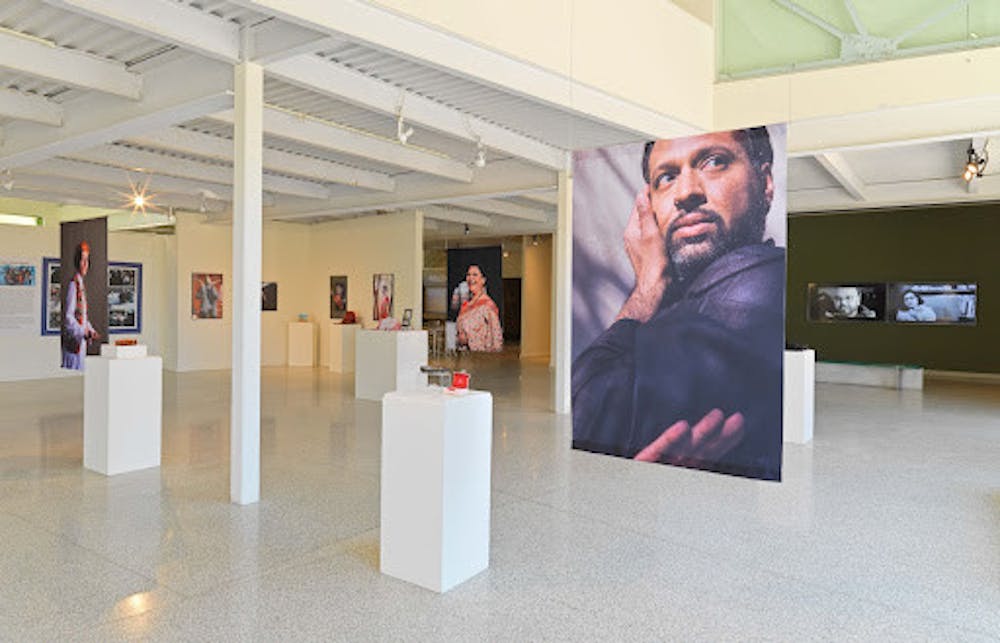By Bailei Burgess-Simmons
Staff Writer
The Grounds For Sculpture (GFS) — a 42-acre sculpture garden in Hamilton with over 300 sculptures — presented its newest exhibit, Local Voices: Memories, Stories and Portraits, on April 23.
In a press release, the GFS team described the exhibit as “a multifaceted look at New Jersey’s Indian diasporic community through the first-person narratives, images and objects of 15 ‘storytellers’ from the community, who present a range of uniquely personal stories.”
But to understand the true power of this exhibit, one must first understand how it became. The vision of the GFS team revolves around curating works that amplify the voices of the people in the surrounding communities whom they serve. So, they strive for an audience-driven experience.
GFS Executive Director Gary Garrido Schneider approached the podium to further explain the idea of an audience centric approach.
“We’ve always applauded ourselves for making art approachable and accessible,” Schneider said. “We’re thinking very intentionally about widening the definition of who is welcomed and who has a sense of belonging.”
So, this exhibit was curated with the hopes of telling the stories of others.
To introduce the “Local Voices,” Kathleen Ogilvie Greene, a co-curator of the exhibition who is also chief audience officer at GFS, explained that “‘Local voices’ is hyper-personal. It’s about the individual stories that we all tell. It’s about love, loss and resilience. Those key stories that you hear in movies and in your favorite books, in the songs that really get you. We all hold those stories as individuals.”
It was no surprise that Local Voices came to be as it did. “We have always trusted artists, Trusted artists in both the ways we support them, and give them ways to create. But we also trust artists to help us see new ways of being in the community and the world. Both of these exhibits are audience led and community driven,” Schneider explained.
“That agency of diving into specifically the Indian community was done as a reflection of our 2021 audience demographics… We have 10% of our audience at Grounds For Sculpture who self identify as Asian and there are multiple communities that tie into who self identify as Asian so we have to pick one community to really deep dive in,” Greene explained. Unbeknownst to most, the U.S. has one of the largest Indian populations outside of India.
Greene was followed by the exhibitions’ other co-curator Quentin Williams, a curator, activist and poet.
“These exhibits are really about storytelling,” Williams said. “Stories are a vehicle that enables catharsis and allows people to process trauma.”
With the introduction of the exhibit, Williams hoped the audience will self reflect and challenge the stories they tell themselves.
“Stories are the distance you share between two people,” Williams said. “One of the questions being asked through these two exhibits is…In what ways might we use stories to build a more inclusive and understanding tomorrow?”
Local Voices was curated with the hope of sharing the stories of members of New Jersey’s Indian population as honestly and as holistically as possible.
GFS partnered with artist Madhusmita “Madhu” Bora, a folk and traditional artist, teacher, writer and journalist, as well as an Assamese American dancer and founder of Sattriya Dance Company.
Madhu was able “to gather oral histories that would present a range of uniquely personal stories from New Jersey’s robust Indian diasporic community,” according to the GFS press release.
It was no easy feat considering the entire process took 10 months. “The images, objects, and stories within the Local Voices exhibition are the result of her building relationships with individuals, the ‘storytellers,’” explained the aforementioned release.
To further adhere to the mission of an audience-centric view, rather than Bora retelling the stories of the storytellers, “The selected 15 individuals were then invited to share their stories, select an object of meaning, and craft their image with full autonomy, to create a powerful exhibition,” Bora explained.
The exhibition featured portraits of all 15 storytellers and a wide array of objects that represented them. It also presented a looping reel of all 15 members sharing their heartwarming, and some heartbreaking, stories.
“As people, we always surround ourselves with folks that speak the same language or practice the same faith or come from the same regions,” Bora said. “There’s a natural tendency as humans to be in that comfort safe zone and this project totally debunked that.”
The exhibit is ultimately a learning opportunity. “The biggest lesson that I came away with was resilience,” Bora said. “There was a lot of intention put into which voices get represented and within the Asian community there is this whole modern minority myth and this debunks that because there are folks who are artists. Like when you think of Indians, you think doctors and engineers. I am so proud that there is not a single doctor here. We have everyone from a gas station attendant to a preschool teacher to a rap and hip hop artist.”
Because stories are better told from the first person, the GSF team urges people to visit and immerse themselves in the rich stories of the Local Voices.
Correction: A previous version of this story stated that GFS Executive Director Gary Garrido Schneider was a co-curator of the exhibit, which is not correct. The story has been updated to reflect that Kathleen Ogilvie Greene and Quentin Williams are the co-curators of the exhibit.







